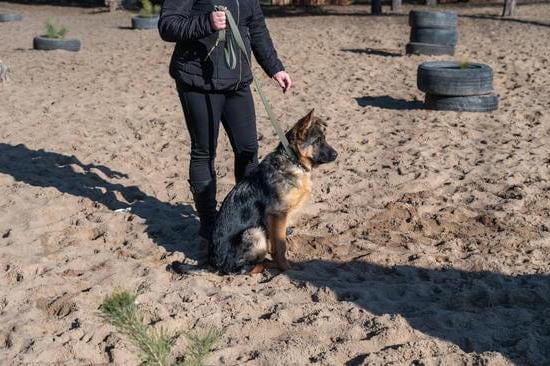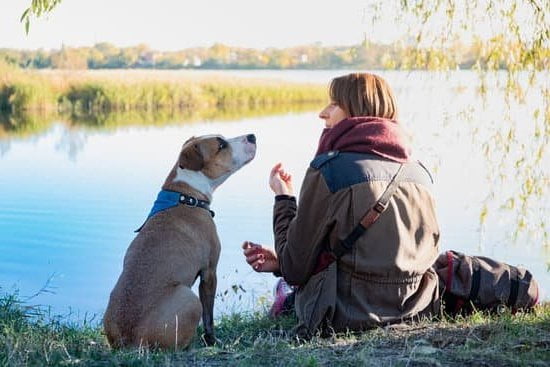Are you wondering how to train a dog on an underground fence? Training your dog to respect boundaries and stay safe within your property can be a challenging yet rewarding experience.
When it comes to underground fencing, it can provide your furry friend with the freedom to roam without the need for traditional physical barriers. In this article, we will explore the ins and outs of training a dog on an underground fence, from understanding its benefits to troubleshooting common issues during the training process.
Underground fences, also known as invisible or electric fences, are becoming increasingly popular among dog owners who want to give their pets the best of both worlds – freedom to roam and safety within designated boundaries. The concept revolves around using a buried wire and collar system to create a virtual barrier that deters your dog from straying beyond certain limits. This modern solution offers an alternative to traditional fences while still providing a controlled environment for your pet.
In the following sections, we will delve deeper into the process of training your dog on an underground fence – from choosing the right system for your pet’s needs to preparing them for training and introducing them to the new boundaries. We will also cover essential dos and don’ts of training, troubleshooting common issues that may arise during the process, and tips for maintaining and reinforcing your pet’s training on the underground fence.
By the end of this article, you’ll have all the tools necessary to successfully train your dog on an underground fence.
Understanding the Benefits of Using an Underground Fence for Training
An underground fence can be a valuable tool for training your dog, providing both safety and freedom. The primary benefit of using an underground fence is the ability to set boundaries for your dog without the need for physical barriers like walls or traditional fences.
This gives your pet the opportunity to roam and explore within a designated area while preventing them from wandering off into potentially dangerous situations. Additionally, underground fencing allows for a more aesthetically pleasing and unobtrusive solution compared to visible above-ground fences.
Another advantage of using an underground fence for training is the flexibility it offers. Unlike traditional fencing, an underground fence can be easily installed and customized to fit the specific needs of your property. Whether you have a large yard or limited space, you can create a boundary that accommodates your dog’s exercise and play needs.
Furthermore, an underground fence provides added security for your pet by keeping them within the confines of your property. This can be especially beneficial in rural or suburban areas where there may be risks such as wildlife encounters or busy roads. By using an underground fence, you can give your dog the freedom to enjoy their environment while ensuring their safety at the same time.
Step-by-Step Guide on Choosing the Right Underground Fence for Your Dog
When it comes to choosing the right underground fence for your dog, there are several factors to consider in order to ensure the effectiveness and safety of the system. Here are some steps to guide you through the selection process:
- Determine your dog’s size and breed: Different underground fences are designed for different sizes and breeds of dogs. It’s important to choose a system that is suitable for your dog’s specific needs.
- Consider the area of coverage: Assess the size of the area where you want to contain your dog. Some underground fences offer a larger coverage area than others, so make sure to choose one that can accommodate your space.
- Research different brands and models: Take the time to research and compare various underground fence brands and models. Look for features such as customizable correction levels, reliability, and durability.
In addition to these steps, it’s essential to consult with a professional dog trainer or behaviorist who can provide recommendations based on your dog’s individual temperament and training needs. By taking these factors into account, you can make an informed decision when choosing the right underground fence for your dog.
Preparing Your Dog for Underground Fence Training
Before you begin training your dog on an underground fence, it’s essential to ensure that they are ready for the process. This includes making sure that your dog is in good health and of the appropriate age for training.
Puppies should be at least 8 weeks old before starting underground fence training. Additionally, if your dog has any pre-existing health conditions, it’s crucial to consult with a veterinarian to assess whether underground fence training is suitable for them.
Another crucial aspect of preparing your dog for underground fence training is ensuring that they have a solid foundation in basic obedience commands. Your dog should be able to reliably respond to commands such as “sit,” “stay,” and “come” before beginning training on the underground fence. If your dog has not yet mastered these basic commands, consider working with a professional trainer to establish a strong obedience foundation before moving forward with underground fence training.
It’s also important to gradually introduce your dog to the sensation of wearing a training collar, which is an integral part of the underground fence system. Start by allowing your dog to wear the collar for short periods while providing positive reinforcement in the form of treats and praise.
This will help your dog associate the collar with positive experiences, making them more receptive to the training process when it comes time to introduce them to the boundaries of the underground fence.
| Aspect | Consideration |
|---|---|
| Age Requirement | At least 8 weeks old |
| Health Check | Consult with a veterinarian if there are pre-existing health conditions |
| Obedience Foundation | Ensure mastery of basic commands such as sit, stay, and come before starting training |
Techniques for Introducing Your Dog to the Underground Fence
When introducing your dog to an underground fence, it is important to do so gradually and with patience. Here are some techniques for successfully introducing your dog to the underground fence:
- Start with leash training: Before allowing your dog off-leash with the underground fence, it’s important to start with leash training. This will help your dog understand their boundaries and learn to associate the warning signals with the boundary lines.
- Use positive reinforcement: When your dog approaches the boundary lines of the underground fence, use positive reinforcement such as treats or praise to encourage them to stay within the designated area. This will help your dog understand that staying within the boundaries has positive outcomes.
- Allow supervised off-leash time: Once your dog begins to understand the boundaries, you can start allowing supervised off-leash time within the designated area. Be sure to monitor your dog closely during this time to ensure they are respecting the boundaries.
By using these techniques, you can help your dog become familiar and comfortable with the underground fence while also ensuring their safety and well-being.
It’s important to note that every dog is different, and some may take longer than others to adjust to the underground fence. Be patient and consistent in your training methods, and always monitor your dog’s behavior when introducing them to the underground fence. With time and effort, most dogs can be successfully trained on an underground fence system.
Dos and Don’ts of Training a Dog on an Underground Fence
Do: Start With Basic Obedience Training
Before introducing your dog to the underground fence, it’s important to ensure that they have a strong foundation in basic obedience training. This means that they should be able to reliably respond to commands such as “sit,” “stay,” and “come.” Having a good grasp of these commands will make the training process much smoother and more successful.
Don’t: Rush the Training Process
It can be tempting to rush through the training process, especially if your dog seems eager to explore their new boundaries. However, it’s important to take things slow and allow your dog ample time to acclimate to the underground fence. Rushing the training process can lead to confusion and anxiety for your dog, which may ultimately undermine their success with the system.
Do: Use Positive Reinforcement
When training your dog on an underground fence, it’s crucial to use positive reinforcement techniques. This means rewarding your dog with treats, praise, or playtime when they exhibit the desired behavior, such as staying within their designated boundaries. Positive reinforcement helps create a positive association with the underground fence, making it more likely that your dog will respect the boundaries in the long run.
Troubleshooting Common Issues During the Training Process
Training your dog to use an underground fence can be a challenging process, and it’s common to encounter issues along the way. One of the most common problems is when your dog refuses to cross the boundary, even when the collar signals that it’s okay to do so. This can be due to fear or confusion, and it’s important to address this issue with patience and consistency.
Another common issue is when the collar fails to deliver a correction signal when the dog approaches the boundary. This could be caused by various factors such as low battery, improper collar fit, or system malfunction. Regularly checking and maintaining the collar and fence system can help prevent this problem.
Some dogs may show signs of stress or anxiety during training, which can manifest in behaviors like excessive barking, panting, or attempting to escape the yard. It’s important to recognize these signs and make adjustments to the training approach if necessary. Additionally, always ensure that your dog has a safe space within the containment area where they feel comfortable and secure.
These are just a few examples of common issues that may arise during underground fence training. By being aware of these potential issues and taking proactive measures to address them, you can help ensure a smooth training process for both you and your dog.
| Common Issue | Solution |
|---|---|
| Refusal to Cross Boundary | Address with patience and consistency; consider positive reinforcement techniques |
| Collar Failure | Regular maintenance checks; proper fit; replace batteries as needed |
| Stress and Anxiety | Recognize signs of stress; provide a safe space within containment area; consider adjusting training approach |
Gradual Transition to Off-Leash Freedom With the Underground Fence
Understanding the Importance of Gradual Transition
When it comes to training your dog on an underground fence, it’s essential to understand the importance of a gradual transition to off-leash freedom. This process allows your dog to become accustomed to the boundaries set by the underground fence without feeling overwhelmed or anxious. Gradual transition also helps in reinforcing the training and ensuring that your dog understands the consequences of crossing the boundary.
Supervised Off-Leash Time
Once your dog has shown signs of understanding and respecting the boundaries set by the underground fence, you can start introducing supervised off-leash time. This means allowing your dog to roam freely within the boundaries while you keep a close eye on their behavior. During this phase, it’s crucial to reward positive behavior and redirect any attempts to cross the boundary with gentle guidance.
Monitoring and Reinforcement
As you gradually increase your dog’s off-leash freedom, it’s important to continue monitoring their behavior and reinforcing the training. This includes regular check-ins to ensure that they are staying within the designated area and addressing any issues or concerns that may arise.
Additionally, providing consistent rewards for obeying the boundaries will further solidify your dog’s understanding of how the underground fence works. By maintaining a vigilant approach during this transition phase, you can help your dog enjoy off-leash freedom while remaining safely contained within their designated area.
Tips for Maintaining and Reinforcing Your Dog’s Training on the Underground Fence
In conclusion, training a dog on an underground fence can be an effective and humane way to ensure your pet’s safety while still allowing them the freedom to roam. By following the step-by-step guide outlined in this article, you can select the right type of underground fence for your dog and prepare them for the training process.
Introducing your dog to the fence with positive reinforcement techniques and avoiding common training mistakes will set the stage for success.
Additionally, troubleshooting any issues that arise during the training process and gradually transitioning to off-leash freedom will further solidify your dog’s understanding of how to navigate the underground fence. Once your dog has been trained on the fence, it is important to maintain and reinforce their training. This can be achieved through consistent monitoring, regular boundary checks, and reinforcing positive behavior with rewards.
Overall, maintaining your dog’s training on the underground fence requires dedication and patience, but it is well worth the effort. With proper maintenance and reinforcement, you can trust that your dog will safely enjoy their newfound freedom within the boundaries of the underground fence. And remember, always be attentive to your pet’s behavior and adjust their training as needed to ensure their continued safety and well-being.
Frequently Asked Questions
How Do I Get My Dog Used to an Underground Fence?
To get your dog used to an underground fence, it’s important to start by introducing them to the boundary slowly. Use training flags to mark the perimeter and walk with your dog around the boundary while holding their leash.
Allow them to explore and get comfortable with the area. Then, gradually introduce them to the correction level of the fence, using positive reinforcement and treats as they learn where they should not cross.
How Long Does It Take a Dog to Get Used to an Underground Fence?
The time it takes for a dog to get used to an underground fence can vary depending on their temperament, breed, and previous training. Some dogs may adjust in just a few days, while others may take several weeks. Consistent training with positive reinforcement is key in helping your dog understand and respect the boundaries set by the underground fence.
Is Underground Fence Good for Dogs?
An underground fence can be a good option for some dogs, especially those who are prone to wandering off or have a strong prey drive. It provides them with freedom to roam within a designated area while keeping them safe from potential dangers like traffic or wildlife.
However, it’s important to pair an underground fence with proper training and supervision to ensure that it is a safe and effective solution for your specific dog.

Welcome to the blog! I am a professional dog trainer and have been working with dogs for many years. In this blog, I will be discussing various topics related to dog training, including tips, tricks, and advice. I hope you find this information helpful and informative. Thanks for reading!





